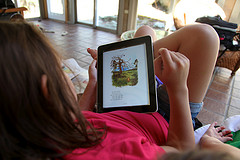By Lindsey Wright, for The Children’s Book Review
Published: January 28, 2010
 These days it seems nearly everyone has a Kindle or iPad. From businessmen who use the devices to keep up on the stock market and the news, to students enrolled in OnlineSchools.org who use their iPad or Kindle to do homework, the reasons for having an e-reader, and the benefits supplied by them, are endless. TheHuffingtonPost reports e-book readers and applications are one of the fastest growing trends with more than six million devices sold in 2010. Following the holiday season, e-book publishers saw a major increase in sales representing an exponential increase over last year’s numbers. While e-books sales account for a small portion of the overall market, children’s books are seeing instant benefits. E-books combine interactive features, sound effects and high-resolution graphics in a compact, kid-friendly package that is creating unlimited potential for innovation and growth.
These days it seems nearly everyone has a Kindle or iPad. From businessmen who use the devices to keep up on the stock market and the news, to students enrolled in OnlineSchools.org who use their iPad or Kindle to do homework, the reasons for having an e-reader, and the benefits supplied by them, are endless. TheHuffingtonPost reports e-book readers and applications are one of the fastest growing trends with more than six million devices sold in 2010. Following the holiday season, e-book publishers saw a major increase in sales representing an exponential increase over last year’s numbers. While e-books sales account for a small portion of the overall market, children’s books are seeing instant benefits. E-books combine interactive features, sound effects and high-resolution graphics in a compact, kid-friendly package that is creating unlimited potential for innovation and growth.
Kids aren’t the only ones enjoying the newest generation of interactive features available with e-books. Parents love the convenience and low cost of e-books. According to Rocco Staino from the Empire State Center for the Book, Americans in their 30s, who also have children, were among the first to adopt Apple’s iPhone and iPad products. This phenomenon led to the early popularity of children’s e-book titles. With the prices for e-readers and related technology dropping, it’s projected more than 11 million e-readers will sell in 2011.
Today, new releases are available alongside classics that have been updated with slick graphics and a multitude of interactive features. According to Wired Magazine, the newest wave of interactive features creates a hyperactive story environment incorporating original music, sound effects, text, multimedia elements and video in a seamless package. For instance, some interactive children’s e-books include a “look and listen” narration feature that highlights text as it is read. Likewise, other e-books include special features such as music and sound effects that create a reading experience that’s exciting for kids. Customizable settings allow narration and sound effects to be turned on and off. Some publishers also offer tools with pronunciation assistance and definitions to aid in learning comprehension.
Today’s kids are very sophisticated and tech-savvy, preferring text-rich chapter books to the picture books that were traditionally marketed to their age group. While the New York Times reported on the drastic decline of the picture book in recent years, the e-book presents a new opportunity for authors and artists to bring back the picture book by creating high-resolution e-books with complex and abstract concepts that encourage creative and critical thinking.
Disney, Scholastic and Marvel Comics are among the first publishers to embrace and package interactive e-books for children. These publishing powerhouses, along with independent media developers, have licensed the rights to build interactive content around the legendary Dr. Seuss series and other popular books. Disney’s unique tools allow kids to change the story’s outcome to fit their vision; while Scholastic and other companies are experimenting with tilt-activated and touch-screen activities, such as virtual finger painting and experiencing interactive sensations related to the story.
Interactive e-books for children are available with Apple’s iPad, The Amazon Kindle, The Barnes & Noble Nook and Sony’s eReader. However, the iPad and its apps seem to have an advantage over other e-readers when it comes to viewing image-based books. With the iPad, readers can change the way they view their e-book simply by turning the screen from vertical to horizontal. Similarly, the device’s frame-by-frame, page-by-page and touch-to-zoom technology is rapidly improving the accessibility and appeal of digital comics, graphic novels and other multi-media publications.
While some consumers may still be leery of replacing traditional books with readers, it is crucial that consumers do ultimately embrace this technology, as interactive e-books are great education tools for children and young adults. Data from The Kids & Family Reading Report published by Scholastic shows that approximately 80 percent of kids read for fun at least once per week. On the other hand, the U.S. government’s official Time Use Survey published by the Bureau of Labor and Statistics, shows young adults between the ages of 15 and 19 spent only five minutes reading on an average weekend day.
Clearly kids enjoy reading, but it seems that they often lack the motivation to pick up a book and read when there so many other forms of media to distract them. However, it appears this disconnect can be remedied through the use of e-readers. According to Scholastic’s Reading Report, more than 50 percent of kids 17 and under said they would read more if they had access to e-reader technology. The clear solution is to begin using e-readers as educational tools. The interactive e-books that can be purchased on iPads and Kindles are now created in a way that falls between traditional books and video games, making them more entertaining than traditional books. Thus using these e-books to educate kids will not only make learning more fun, but kids will also be much more inspired to read
Lindsey Wright is a music tutor, computer repair consultant, and substitute teacher in Washington State.
Image courtesy of Travis Warren.


2 Comments
I totally agree that everyone these days has a digital device of some sort, I also agree that interactive books on e-readers would be great for children. Apple most certainly have started down this route with enhanced illustrative apps for producing ebooks, but it is only the beginning.
I feel the beauty of an ebook is that the only limitation is what you can imagine!
Hear, hear! I can’t wait to see what comes next.